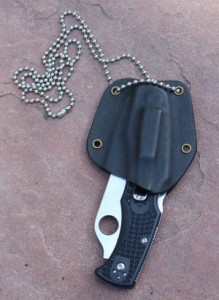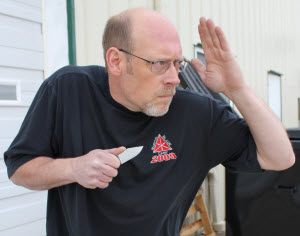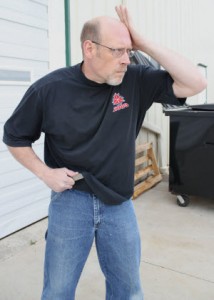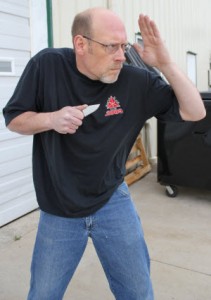Those of you who live in areas with distinct seasonal changes know what I’m talking about. When the weather is cold, weapon concealment is easy. Wearing a jacket or sweatshirt is no problem. It not only keeps you warm, but it also provides plenty of cover garment to conceal your personal-defense tools. However, when temperatures rise and you’re down to a short-sleeved shirt and shorts, concealed carry gets a lot more challenging.
Obviously, carrying and effectively concealing a full-sized pistol is more challenging when you’ve got less clothing—as well as lighter-weight clothing—to work with. This is certainly one time when carrying a knife or knives for personal defense is a very viable alternative to a gun. Is a knife as potent a weapon? Definitely not. However, it is much better than nothing, and you can conceal and have it with you in some form even when you’re shirtless and down to your swim trunks (no Speedos, please).
From Pants to Shorts
If you carry a knife the rest of the year, you’ve probably settled on a preferred carry method based on your typical mode of dress. In most cases, this will be a folding knife clipped to the strong-side pocket of your pants. Those pants will also usually be worn with a belt and have significant weight and friction against your legs due to the full-length pant legs. When you reach for your clip-carried knife and draw, the pants stay in place and the knife comes out quickly and easily.
Fast forward to the summer months, and you’re now wearing a pair of shorts. Your belt is gone, since the shorts have a drawstring waist, but the pocket is still there. You clip your trusty folder in place, reach down to draw, and practically pull your shorts up over your head. The lack of weight and, very importantly, lack of friction of the long pant legs against your legs allow the light shorts to move with the knife. If the shorts are loose-fitting, you’ll also find that the weight of the knife makes it swing around and bang into things a lot.
One solution to this problem is to adjust your carry position from the pocket to appendix carry. This moves the knife up a few inches and clips it to the waistband of the shorts, right in the crease of the hip. Like any other adjustment to your carry strategy, this will require a bit of practice to re-program your draw. However, it’s not a drastic change and you should be able to adapt quickly.
Appendix carry is a great warm-weather option, but it does have two disadvantages: first, it doesn’t work well for guys with “ample” frames. Let’s face it: if you’ve got to lift more than your shirt to find your waistline, it’s probably not a good location for quick access.
If your physique does make appendix carry an option, the other disadvantage is that you still need to worry about the effects of perspiration on anything you carry there. Smooth-handled knives can become extremely slick and difficult to draw when you sweat on them, and all knives carried there can be susceptible to rust. In addition to careful cleaning and maintenance, you might also consider investing in a truly rustproof knife, like Spyderco’s Salt series made from H-1 steel. H-1 is a unique steel that is made with nitrogen instead of carbon, which makes it completely immune to rust and ideal for warm-weather, close-to-the-body carry.

Carpenter style jeans have an additional long side pocket. Source: www.workzonegear.com
www.personaldefensenetwork.comShort Long Pants
If you like to wear shorts, you might want to consider a style that more closely replicates your typical taste in long pants. This makes it much easier to choose one standard carry “load” that you can maintain all year round. For example, I’m a big fan of carpenter-style jeans. In addition to the standard pocket configuration, they also have a side pocket intended for pencils, pens, rulers, etc. that is a perfect home for my writing tools and a clip-carry tactical flashlight.
Carpenter jeans are generously cut, so they provide excellent range of motion and aid in concealment. They are available in different shades of denim, but can also be found in black, khaki, and other colors that support a slightly more “upscale” appearance for circumstances where jeans are inappropriate. Best of all, you can also get carpenter jeans as shorts. They have all the same pockets in all the same places, so your standard gear load can remain consistent. They also extend lower and have more mass than lightweight shorts, stabilizing the fabric to make clean, snag-free draws much easier.
If you’re not a fan of the carpenter style, you can take a similar approach with your preferred pant fashion and either find identical shorts or have them tailored from full-length pants.

Neck knives are excellent warm-weather personal-defense tools that fit with all styles of dress. In this sequence of photos, the author demonstrates a proper neck knife draw.
www.personaldefensenetwork.comNeck Knives
One other warm-weather alternative for edged-weapon carry is a neck knife. Neck knives are typically small fixed-blade knives that ride handle down in a snap-fit or friction-fit sheath hung on a cord or chain around the neck. Since neck knives hang around your neck, they are pretty much immune to the restrictions of fashion. As long as you’re wearing a shirt of some sort and your head is attached, they are a viable option. That’s why neck knives are extremely popular with women, joggers, and even white-collar types for whom a knife clipped in a pocket is not an option.
But neck knives do have a number of disadvantages. First of all, they are typically fixed blades, which may cause legal issues in jurisdictions where only folders are allowed. As always, you need to do the research and determine what’s permitted in your area. One complicating factor when it comes to neck knives and legal issues is that many of them are “skeletonized,” meaning they are all-steel construction without handle scales. While this makes them flat and light, it also makes it difficult to determine where the blade stops and the handle begins, which also means determining the actual length of the blade can be up to interpretation.
Drawing a Neck Knife
If you choose to carry a neck knife, you should first focus on a proper carry position and sound deployment methods to ensure that you can get the knife into the fight when needed. The exact positioning of your neck knife will depend on your height, physique and the knife/sheath combo you choose. Ideally, it will ride in front of the sternum with the end of the handle just above the solar plexus. If it rides too low, the end of the handle will tend to print through your shirt, especially if you’re “well fed.”

One way to compensate for the lack of potency of most neck knives is to combine neck carry with a more capable lightweight folding knife. This Kydex neck rig from River City Sheaths is the best of both worlds, combining convenient all-weather carry with a full-service Spyderco Endura folding knife.
www.personaldefensenetwork.comNeck Knife Tactics
Once your knife is out, you should apply the tactics and techniques of your knife-fighting skill set, adapting them to the limitations of your weapon. You should also objectively consider the capabilities of your neck knife and whether it is a true fight stopper. Many small, thrust-oriented neck knives are useful defensive tools, but only if backed with fight-stopping empty-hand skills. I recommend gripping these knives with the handle butt braced against your palm, and your index finger extended along the blade. In this grip, poking with your index finger translates directly into powerful, accurate thrusts with the blade. Attack the eyes or face to compromise your attacker’s vision and get his attention up high. Then immediately follow with powerful low-line kicks to the knees or ankles to destroy his legs and mobility. This integrated use of the knife and low-line kicking is a much more efficient way of decisively stopping your attacker than trying to cripple or kill him with a micro-sized blade.
Best of Both Worlds
If you’re a fan of neck carry but still want the more potent performance of a more substantial folding knife, one option is to combine the two. A number of years ago, I met Mike Sastre, custom Kydex wizard and founder of River City Sheaths. Mike is also an avid kayaker and former videographer for the U.S. whitewater kayak team. When members of the team started looking for a way to carry small folding knives in a way that kept them accessible while in the water, Mike designed a Kydex neck sheath that carried a folder in the closed position. The custom-molded sheath, which is suspended from a breakaway ball chain, provides positive retention of the knife while allowing for a quick draw that feeds directly into a fluid opening technique. It works best with Spyderco folders, which can be drawn with a pinch grip on the trademark round blade hole and immediately opened with a “handle-drop” opening technique.
Although getting Sastre’s custom work can take awhile (he’s a one-man shop), the concept can be executed by other Kydex makers or even homemade by an enterprising craftsman. The result is a sheath that combines the convenience and warm-weather concealability of neck carry with the more potent combative potential of a folding knife. When used with lightweight folding knives with injection-molded nylon handles, the weight is comparable to a skeletonized fixed blade, yet it is even more easily concealed due to its shorter length.
No matter which method you choose, make sure you train diligently to ensure that when you change your carry method for warm weather, your reflexes and tactics change too.







Share tips, start a discussion or ask other students a question. If you have a question for an expert, please click here.
Already a member? Sign in
No Responses to “Blade Carry Strategies for Warm Weather”